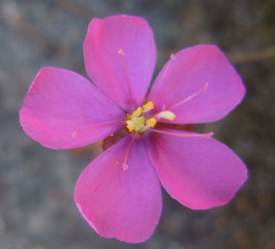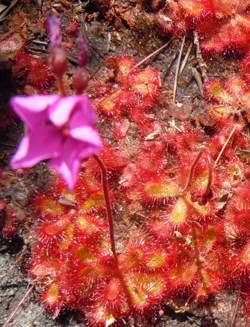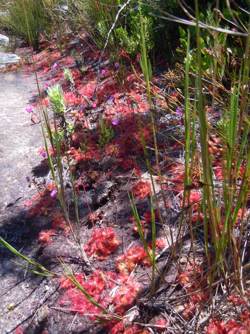Drosera cuneifolia
Drosera cuneifolia L.f.
Family: Droseraceae
Common names: peninsula sundew (Eng.); skiereiland sondouw, vlie & euml; vangertjie (Afr.)
Introduction
Drosera cuneifolia is a winter-growing sundew that is restricted to the Cape Peninsula.

Description
Description
Drosera cuneifolia is a perennial carnivorous plant. The basal rosette is loosely clumped and formed by quite broad, wedge-shaped leaves, 20-40 mm long and 10-15 mm wide. The leaves are greenish with 3-5 veins, and the lower leaf surface is almost smooth. Both marginal and discal tentacles are present. The dense marginal tentacles are longer while the rest are shorter, red and knob-ended. The plants have a few, fairly long roots.

The flowering stalk is leafless, rarely branched and erect, originating from the centre of the rosette, 100-200 mm long and bears multiple pink to mauve flowers. The petals are 10-15 mm long. The styles are spoon-shaped. Flowering time: November to January. Black spindle-shaped seeds are formed in a capsule and released a few weeks after flowering.
Conservation Status
Status
Drosera cuneifolia is of Least Concern and not threatened.
Distribution and habitat
Distribution description
Drosera cuneifolia is endemic to South Africa and restricted to the Table Mountain complex in the Western Cape. Plant colonies can usually be found in damp, peaty areas in seeps or exposed flat and sandy areas amongst fynbos vegetation at altitudes up to 915 m. They have been noted by T.M. Salter to occasionally grow on the flats south of Smitswinkel.

Derivation of name and historical aspects
History
The genus Drosera was named by Linnaeus in 1753, and consists of ± 126 species, of which 23 are known to occur in South Africa. Drosera gets its name from the Greek word, droseros, meaning dewy. The epithet cuneifolia refers to the wedged-shaped leaves.
Drosera cuneifolia was first described in 1781 by Carl Linnaeus the Younger (1741-1783), a Swedish naturalist and son of the famous systematist Carl Linnaeus.
Ecology
Ecology
Drosera cuneifolia is a winter-growing sundew and usually goes dormant during summer.
Flowers are open very briefly for a few hours with good sunlight. The flowers can be pollinated by insects, but are usually self-pollinated. When the seeds are ripe, their capsules open to release the fine, light-weight seeds which fall out and are dispersed near the parent plants.
Probably the most interesting characteristic of this plant is its ability to digest the nutrients, especially the nitrogen, it requires from insects caught in its stalked tentacles. Different types of glandular growths include marginal tentacles situated near the lamina (leaf blade) margins, discal tentacles which are shorter and disc-like, usually on the upper leaf surfaces, digestive glands filled with red fluid, and glandular hair-like growths on the inflorescence. The tentacles are sensitive and mobile. Their stalks end in a bulbous head in which the glandular cells occur. These glands secret a glistening, sticky, clear fluid used to trap and retain prey. There is speculation that the fluid is slightly sweetly scented to attract insects. The fluid contains a weak acid and enzymes that digest the soft parts of the prey. The sensitive tentacles are able to detect caught prey and produce more dew to entrap their victim. Neighbouring tentacles then mobilize and slowly lean over to engulf the hapless victim. The lamina itself may also fold over to enclose or suffocate larger prey and allow for better absorption. As sensitive as these tentacles are, they are able to distinguish between a meal and other stimuli, for example, they do not respond to water droplets.

Uses
Use
Droseras make fascinating house and conservatory plants around the world, but are better suited to being grown outdoors. However, keep them under a roof if you wish to retain their vivid red colouration. Plants can be brought indoors for short periods for display. Drosera cuneifolia is a hardy winter-growing carnivorous plant, but not necessarily the easiest for novices.

Growing Drosera cuneifolia
Grow
A very well drained sandy soil is the best growth medium, 1 part silica grit to 1 part peat or sphagnum moss, in 9-15 cm pots is ideal. It is important not to over-pot plants. Taller rather than wider pots are ideal for Drosera to thrive and to accommodate their few, but long roots. Place the potted plants in a shallow saucer filled with fresh water to keep them moist at all times during their growth season. If using the saucer method, allow the saucer to dry out occasionally so that the medium can aerate. This will not harm your plants so long as the moisture content in the medium is still high. Place in a northern (in southern hemisphere) or eastern situation for best sunlight if growing indoors. Grow in full sun to light shade outdoors. During the plants' dormant period in summer, remove pots from water trays or saucer, but do not allow soil to dry completely. The author allows for very minimal, light watering over the dormant phase. This technique has successfully kept plants alive over their dormant period and allowed mature plants to resprout the following winter. Other growers recommend removing roots and tubers and keeping them in a sealed container in a cool environment.
Sundews are easily propagated by seed. In autumn prepare a 90 mm pot with growth medium; water well. Sow fresh seeds on the surface of moist growth medium. Do not cover the seeds with soil. Place in a warm, semi-shady position, and seeds should germinate in 2-4 weeks. If the seed sown is too dense, the seedlings or groups of seedlings can be transplanted into their own containers to reduce the chance of dampening off, once large enough to handle safely.
Acidic or epiphytic foliar feed may be used at ¼ recommended strength once a month on mature plants.
Ironically, the carnivorous plants are attacked by insect pests. Aphids, mealy bug and thrips cause deformity in new growth. Treat with a diluted pesticide or remove pests by hand. Never use a soap-based insecticide. Drying out can cause drooping and the decrease in mucilage production. Watering and keeping the plant moist will revive them. Dew production may stop after transplanting or if the leaf comes into contact with inquisitive hands or chemical applications. New foliage will, however, grow and continue to produce dew.
References
- Adamson, R.S. & Salter, T.M. (eds) 1950. Flora of the Cape Peninsula . Juta, Cape Town.
- D'Amato, P. 1998. The savage garden: Cultivating carnivorous plants. Ten Speed Press, California.
- Goldblatt, P. & Manning, J.C. 2000. Cape plants. A conspectus of the Cape flora of South Africa. Strelitzia 9. National Botanical Institute, Pretoria.
- Obermeyer, A.A. 1970. In L.E. Codd, B. de Winter & D.J.B. Killick (eds), Flora of southern Africa 13. Botanical Research Institute, Pretoria.
- Smith, C.A. 1966. Common names of South African plants. Memoirs of the Botanical Survey of South Africa No. 35.
- http://redlist.sanbi.org .
Credits
Monique McQuillan
Kirstenbosch National Botanical Garden
June 2013
Plant Attributes:
Plant Type: Carnivorous
SA Distribution: Western Cape
Soil type:
Flowering season: Early Summer
PH:
Flower colour: Pink, Mauve/Lilac
Aspect: Full Sun
Gardening skill: Challenging
Special Features:
Horticultural zones







Rate this article
Article well written and informative
Rate this plant
Is this an interesting plant?
Login to add your Comment
Back to topNot registered yet? Click here to register.